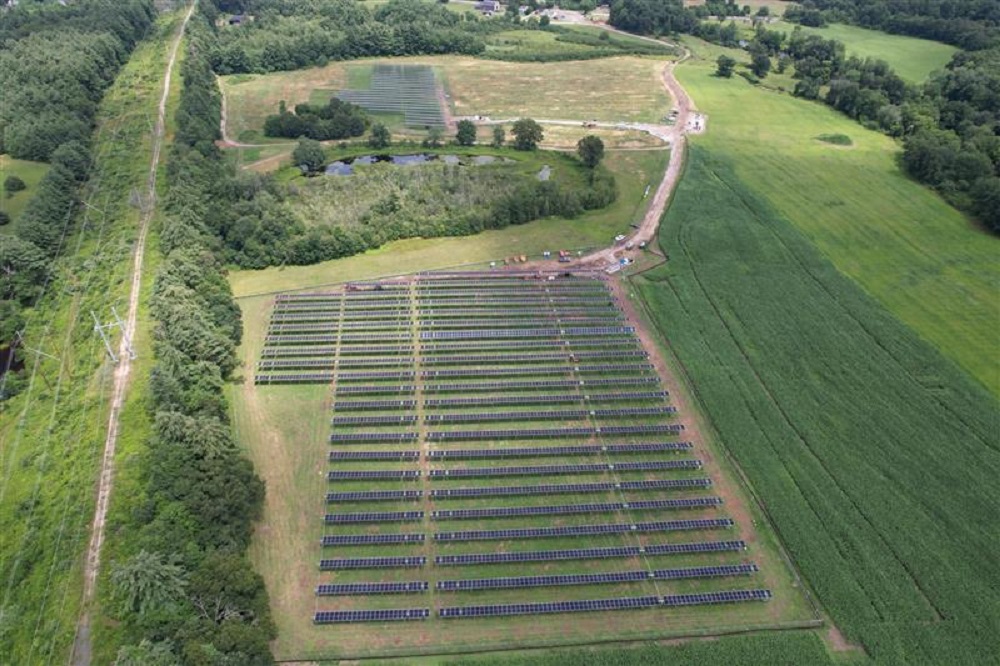Northeast U.S. solar developer and operator BlueWave received $91 million in financing, which the company says will allow it to achieve long-term ownership and management of its portfolio of projects.
The financing will go toward the construction of five projects featuring dual-use solar development attributes, called agrivoltaics, in Massachusetts. These projects are “strategically implemented to benefit all parties impacted by the projects,” including landowners, farmers and the surrounding community, according to BlueWave. The financing includes a $64 million debt raise with KeyBank, and $27 million tax equity raise with U.S. Bancorp Impact Finance.
The five projects include a 3.6 MW facility in Dighton; 3.5 MW facility in Douglas; 2 MW facility in Haverhill; and 2 MW and 8.6 MW projects in Palmer, Jesse Robertson-DuBois, director of sustainable solar development at BlueWave, told pv magazine USA.
The projects will use ATI racking and will all be elevated 10’ to accommodate agricultural operations under the arrays, Robertson-DuBois added. Moreover, the systems are spaced more widely than typical, and account for fence setbacks and turning clearances needed for agriculture equipment.
“These design decisions were all made to ensure efficient farm operations. The combination of added height and wider row spacings results in a minimum of 50% light availability for every square foot of ground,” Robertson-DuBois said.
The project sites include a varied group of crops, pollinator habitats and livestock grazing operations, according to BlueWave. At four of the projects, farming operations will be able to continue uninterrupted beneath the solar arrays, and the fifth includes the creation of a new grazing pasture. All projects are scheduled to come online in 2023, and will be interconnected with National Grid.
BlueWave’s projects will be included under the Solar Massachusetts Renewable Target (SMART) program, and are expected to save money on the bills of around 770 low-income households. The 3,200 MW declining block incentive program was created by the Massachusetts Department of Energy Resources. Eligible projects must be interconnected by one of the state’s three investor-owned utilities, and are paid tariff-based incentives directly by the utility.
Agrivoltaics are a combination of farming practices with solar photovoltaic energy production and is expected to become a $9.3 billion market by 2031. Experts at Allied Analytics say that the practice can help address food security while also transitioning to clean energy. The global installed agrivoltaics output rose from 5 MW in 2012 to 2.9 GW in 2020, according to the company.
Massachusetts is a leader in agrivoltaics, thanks to its SMART solar incentive program, which includes an adder for agrivoltaic systems, Mark Sylvia, chief of staff at BlueWave, told pv magazine USA.
The state’s 2022 Climate Billl also included the creation of an agrivoltaics commission to make recommendations to remove barriers to the further development of agrivoltaic projects, Sylvia added.
In May 2022, BlueWave announced it had been acquired by Axium Infrastructure, an infrastructure investment management firm with a North American renewables portfolio.
The quote by Robertson-Dubois was changed to say “The combination of added height and wider row spacings results in a minimum of 50% light availability”, rather than “maximum”.
This content is protected by copyright and may not be reused. If you want to cooperate with us and would like to reuse some of our content, please contact: editors@pv-magazine.com.








By submitting this form you agree to pv magazine using your data for the purposes of publishing your comment.
Your personal data will only be disclosed or otherwise transmitted to third parties for the purposes of spam filtering or if this is necessary for technical maintenance of the website. Any other transfer to third parties will not take place unless this is justified on the basis of applicable data protection regulations or if pv magazine is legally obliged to do so.
You may revoke this consent at any time with effect for the future, in which case your personal data will be deleted immediately. Otherwise, your data will be deleted if pv magazine has processed your request or the purpose of data storage is fulfilled.
Further information on data privacy can be found in our Data Protection Policy.